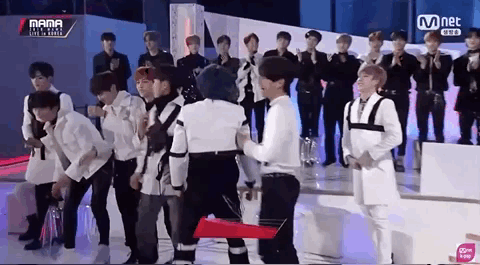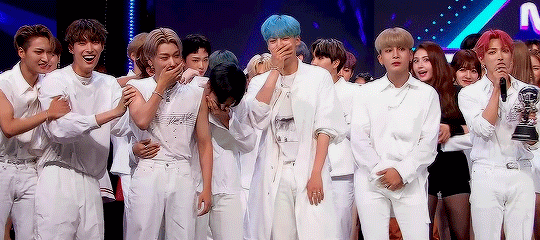How Fan Marketing Pushes K-Pop forward
- Brie
- Aug 29, 2020
- 8 min read
Updated: Aug 30, 2020

As a self-proclaimed veteran K-Pop stan and recent business/marketing grad, I've noticed that K-Pop marketing relies on a combination of fan marketing and a strict, coordinated promotional cycle. Yes, almost all brands or artists use some combination of these two things, but K-Pop does it so strategically and really emphasizes the two. Western artists and companies don't seem to do this as much. It's this successful combo that has made me wonder why the explosion of groups like BTS haven't become a marketing case study yet. Maybe it's because I wasn't a music marketing major or because I didn't take music/entertainment marketing courses. Whatever the reason is, it's something that I've been fascinated with from the start of my K-pop "obsession". Of these components, I'll be writing about the biggest: Fan Marketing.
The official term for "Fan Marketing" is "Direct-to-Fan" marketing. A quick Google search of the term gives plenty of definitions and articles about the subject, but the commonality between each example of the term is that the artist attempts to create a direct relationship with the fans and, through this relationship, the fans take care of pushing the artist to the public eye. All Korean entertainment companies (actually, entertainment companies in general) and artists acknowledge the power of fans. Therefore, there is a lot of effort and resources put into building a dedicated fanbase. A huge part of this is through providing consistent content, even before there is an official "debut". To explain this, we can use three examples: Current K-Pop Kings BTS, MNET's 2018 "Best New Male Artist" Stray Kids, and the 2019 Recipients of the "Next Generation Award", rookie group ATEEZ.
Starting with the biggest group out there right now, BTS could be a whole case study by itself. Their success looked like it was overnight, especially since they have hit so many milestones in their short time in the U.S. public eye. However, it's the accumulation of seven years of working not just on music, but on creating a connection with their fans. Right now, BTS has their own weekly variety/reality show on the V Live app called "Run BTS". It's available for free and is subbed for international fans. Almost every day, there's a short video uploaded to the BANGTANTV YouTube page, giving some short behind-the-scenes looks at music video shoots, music shows, tour prep, and more. They don't use Instagram frequently, but are active on V Live (a livestreaming app dedicated to Korean Pop Stars/actors/actresses) and Twitter. Some members are more active than others, which can build hype for the members that aren't online frequently. When the less active members are online and post pictures, like Jungkook, the internet goes CRAZY, and that one post can hit over a million shares or interactions in under an hour.
Before they made it big, or even debuted, each member uploaded individual vlogs on YouTube. You can still find the seven-year-old videos on the BANGTAN TV channel HERE, just sort the uploads from oldest and they'll pop up. They would talk about their day or week, what was on their mind, do work, or just listen to music. They talked about the nervousness and anxiety they had leading up to their debut, how they worried about succeeding, and all the things they wanted to do with their careers. They do the same with V Live now, but it's live and there are real-time reactions/interactions with fans. It was these raw, open-hearted videos that helped them start building a repertoire with the viewers and helped build a fanbase before they debuted. Fans were able to build a more personal and emotional connection to the members and it's this connection that was used to push them to the spotlight. The fans felt the members deserved recognition. The fans shared and posted about music video releases, tours, albums, TV appearances, Run! episodes and more. ARMY's have a fierce loyalty to the group thanks to the time BTS took to talk to fans. All of these small things helped contribute to their current worldwide success. It's the reason they sell out arenas and merchandise in minutes and why ARMY will defend them to no end.

Korean entertainment companies have also utilized TV competitions as a way to build a fanbase even before a group officially releases music. Such is the case of JYP Entertainment's Stray Kids, who got their start on MNET's survival show of the same name. Each week, members completed challenges and evaluations that determined whether or not they would officially debut with Stray Kids. Viewers rooted for their favorites, and laughed and cried with them too. But that isn't all. The show gave a detailed look into not just their training lives, but also into their relationships with each other. Fans connected with the group and the boys' brotherly bond. Each time one was eliminated, the hurt members felt was also felt by the fans. When the members cried, the STAY fandom C-R-I-E-D. The comments under Felix's elimination clip prove this point. One comment briefly explained the moment a fan's mom walked in and asked why they were crying. The response? "Because Stray Kids is crying."
Two years later, the group is still active on social media. Most members are active on Instagram and Twitter, frequently posting selcas/selfies and short videos for the fans. One of the most anticipated livestreams is Chan's room. Leader Bang Chan sits in a room and plays his current favorites. He will tell stories about his day, promotions, upcoming albums, schedules, music shows, and on rare occasions, even sneak in works in progress. He'll have other members as "special guests" and the livestream becomes just a group of friends hanging out. Any jokes or embarrassing moments that happen on camera become "you had to be there" moments for fans. Even though these moments are often posted on fan accounts, it isn't quite the same as watching it happen in real time. Through streams and moments like this, fans bond with the group and with each other. Again, it's the emotional connection that has built the crazy loyalty STAYs have to Stray Kids.

Last but not least, we have ATEEZ. KQ Entertainment didn't have a survival show for the members, nor were there daily vlogs uploaded. Instead, the company built hype for the group by first dropping ATEEZ's (who were initially named "KQ FELLAZ") first Performance Video, followed by 19 three-minute "episodes" of their training camp in America. These quick clips introduced the members and the group as a whole. KQ took a different approach from the individual vlog style of groups before them, focusing attention to the group's clean, sharp, synchronized dancing/performance abilities as a whole. Nearly a year later, fans were able to get to know the faces hidden by the hats they wore in the performance video. A few months later, there was a short 8-episode reality series on MNET, "Code Name Is ATEEZ," that showed the groups activities right before they debuted. Soon after , KQ uploaded "ATEEZ Wanted," a variety show where fans could follow ATEEZ as they completed various missions/tasks that included things like sky diving, fashion challenges, fun travel adventures, and more. Instead of getting to know each member individually, then as a group, KQ took the opposite approach and introduced them as a whole, then separately. It created interest and made fans want to know more about each member, which is where the different mini-series came in. Now, there are weekly logbooks/vlogs uploaded on YouTube to give fans behind the scenes looks at the members' lives during promotion periods. They also stream on V-Live frequently.

The three groups are very active on social media. There are consistent social media posts, V lives, fan cafe updates, Twitter updates, YouTube videos, TikTok challenges and so much more. Even in the midst of rehearsals, performance and TV appearances, they are on social media in some form, interacting with fans. Groups are constantly working to build and maintain a connection with their fans. But why put so much effort into building a relationship? Each group is extremely successful in their own way because of the fans. Yes, they are all talented and their talent and hard work contributes to their success. However, considering how saturated the Korean music industry is (and music in general), getting into the spotlight is extremely difficult. In 2020, there are at least 24 new groups that are set to debut/have debuted. This doesn't take into account subunits (like Irene&Seulgi from Red Velvet) and solo artist debuts. This number also doesn't account for the fact that there are at LEAST 100 CURRENTLY ACTIVE artists (groups, subunits, solos), and only a few are in the spotlight. It's the fans that get the artist to the top.
The strength of the fan-artist connection and fan marketing approach is evident in artists’ ability to climb the charts with the help of the fans. It's why BTS dominated the charts with each album and their U.S. success started with the Top Social Artist Award at the Billboard Music Awards. It's why ATEEZ, a rookie group, was able to have a U.S. and Europe tour within the first year of activity as a group. It all has to do with music charts and recognition. The more fans there are, the more people there are to stream/download/buy albums and songs. Take BTS' recent release, "Dynamite". Thanks to the power of ARMY, in 24 hours, the music video hit 101.1 million views, breaking YouTube's record for most views in 24 hours. The teaser was used as a sound on TikTok and that alone had millions of posts in a single day. This constant connection with the fans also lessens the amount of marketing/promotion the company needs to do. Although the companies and artists have schedules packed with meetings, interviews, TV appearances and performances, and commercial/TV/MV shoots, fans take over most of the work. They promote the albums, movies, DVDs, TV/movie appearances, and more on their own because they want their artist to succeed. There are hundreds, if not thousands, of kpop pages, blogs, and YouTube channels that promote and review artists, comebacks, music videos, and shows. Fans even hold their own events, where fans come together to bond and even purchase artist-related items. Yes, fans do this normally, but how many Ed Sheeran fans came together to promote his appearance in the movie "Yesterday"? Did it trend?
Do fans of English-language artists hold things like fan cafe events? Do they even know what that is? For example, Goryumi's Goodies, based in NYC, has fan events for Stray Kids and ATEEZ birthdays and anniversaries that are hosted by local New York City cafes. At these events, every drink is sold with cup sleeve that features the artists' faces and names. All of it is crowdfunded and supported. Goryumi's Goodies is also a fan shop that sells fanmade pins, stickers, keychains, etc.. All the designs are fan-made and none of it is promoted by JYP Entertainment or KQ Entertainment. It's all done by the power of the fans. These groups gain exposure to "mainstream" audiences through the fans' dedication. It's this dedication, loyalty, and love, fostered by constant fan interaction and content, that helps artists become successful. It's why the artist can be catapulted to the spotlight, why they can climb the charts, and why they can eventually have appearances on Fox 5, GMA, and in Vogue. All of this is why Fan Marketing is emphasized so much in kpop. It's how the genre itself has become so well-known globally and why it's so successful in Korea. Fan Marketing acknowledges that fact that fan power is like the Energizer bunny: it just keeps going. If U.S./English artists focused in on fan marketing, the success might even double internationally. Who wouldn't want that?



Comments